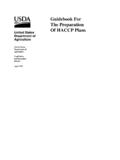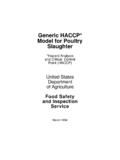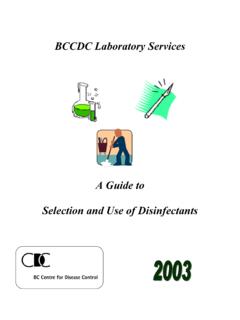Transcription of Reference Document: Anmicrobial Intervenons for Beef
1 Reference document : An/ microbial Interven/ons for Beef Developed by: Dawna Winkler and Kerri B. Harris Center for Food Safety Department of Animal Science Texas A&M University College Sta/on, TX 77843 2471 May 2009 This project was funded by beef and veal producers and importers through their $1 per head checkoff and was produced for the CaYlemen s Beef Board and state beef councils by the Na/onal CaYlemen s Beef Associa/on. 1 Reference document : antimicrobial Interventions for Beef Developed by: Dawna Winkler and Kerri B. Harris Center for Food Safety Department of Animal Science Texas A&M University College Station, TX 77843-2471 May 2009 (revised: May 15, 2009) This project was funded by beef and veal producers and importers through their $1-per-head checkoff and was produced for the Cattlemen s Beef Board and state beef councils by the National Cattlemen s Beef Association.
2 2 antimicrobial Interventions for Beef microbial contamination of beef carcasses and raw meat products may occur during harvesting and subsequent processing. Throughout the process, contamination may be introduced onto the edible product from the hide, gastrointestinal tract, workers, and the environment. The beef industry acknowledges that microbial contamination may occur; however, it has taken multiple actions to reduce the potential for contamination. And it has incorporated, scientifically proven antimicrobial interventions that can be applied individually or in combination with other treatment to reduce the pathogens on the carcass surfaces.
3 This document provides information on the commonly applied interventions. The document provides scientific references that are available for the different interventions. For some interventions, USDA s Food Safety and Inspection Service has defined limits for use and labeling requirements, and these are also provided. The Reference list at the end of the document provides links to the journal article for those that are available electronically. If you need additional information or assistance in obtaining an article, please call 979-862-3643. Note: This document will be updated with new information as additional scientific studies are identified or conducted.
4 If you are aware of additional research that should be included or find errors in the information provide, please let us know and the document will be revised. 3 Hot Water Wash Product(s): Applied to beef carcasses; heads Amount approved for use: Not applicable Labeling Requirements: Not applicable Scientific References: Kalchayanand, et al,. 2008. Hot water was applied to bovine heads for 12 and 26 seconds at 74 + 2 C using a commercial spray cabinet. Achieved a log reduction when applied for 12 seconds; and a log reduction when applied for 26 seconds. Algino, 2007 This study was conducted in 22 very small commercial facilities in Wisconsin.
5 The hot water intervention consisted of either washing the carcass with C (150 F) water using a low-pressure spray nozzle or spraying C (120 F) water at kPa (1000 psi) using a pressure washer prior to chilling. Hot water was applied using a hand-held nozzle. There was no significant difference (P> ) between intervention treatments, and all treatments caused significant reductions (P< ) in indicator organisms. Bosilevac, Joseph M. 2006. A commercial hot water carcass wash cabinet applying 74 C (165 F) water for s reduced both aerobic plate counts and Enterobacteriaceae counts by log CFU/100 cm2 on preevisceration carcasses.
6 A commercial lactic acid spray cabinet that applied 2% L-lactic acid at approximately 42 C (105 to 110 F) to pre-evisceration carcasses reduced aerobic plate counts by log CFU/100 cm2 and Enterobacteriaceae counts by log CFU/100 cm2. When the two cabinets were in use sequentially, , hot water followed by lactic acid, aerobic plate counts were reduced by log CFU/100 cm2 and Enterobacteriaceae counts were reduced by log CFU/100 cm2. Hot water treatments reduced Escherichia coli O157:H7 prevalence by 81%, and lactic acid treatments reduced E. coli O157:H7 prevalence by 35%, but the two treatments in combination produced a 79% reduction in E.
7 Coli O157:H7, a result that was no better than that achieved with hot water alone. Castillo et al., 1998 High-pressure water wash at 35 C or trim, alone and combined with sanitizing treatments, such as hot water (95 C at the source), warm (55 C) 2% lactic acid spray, and combinations of these two sanitizing methods, were compared for their effectiveness in reducing Salmonella typhimurium, Escherichia coli O157:H7, aerobic plate counts, Enterobacteriaceae, total coliforms, 4 thermotolerant coliforms, and generic E. coli on hot beef carcass surface areas. The different combined treatments had higher log reductions than independent treatments.
8 The range for mean log reductions: hot water was from to > log CFU/cm2, by lactic acid spray was from to > log CFU/cm2, by hot water followed by lactic acid spray was from to > log CFU/cm2, and by lactic acid spray followed by hot water was from to > log CFU/cm2, for S. typhimurium and E. coli O157:H7. Castillo et al., 1998a Hot water treatment of beef carcass surfaces for reduction of Escherichia coli O157:H7, Salmonella typhimurium, and various indicator organisms was studied. Inoculated carcass surfaces were exposed to a carcass water wash or a water wash followed by hot water spray (95 C).
9 All treatments significantly reduced levels of pathogens. Treatments including hot water sprays provided mean reductions of initial counts for E. coli O157:H7 and S. typhimurium of and log, and APC reductions of log. Acidified sodium chlorite Product(s): Meat carcasses, parts, and organs Processed, comminuted, or formed meat food products (including RTE0 Poultry carcasses and parts Amount approved for use: 500 to 1200 ppm in combination with any GRAS acid at a level sufficient to achieve a pH of to in accordance with 21 CFR (Note: The pH depends on the type of meat or poultry product) Labeling Requirements: None under the accepted conditions of use And: Product(s): Red meat, red meat parts and organs, and on processed comminuted, formed meat products (including RTE) Amount approved for use.)
10 Applied as a spray or dip, the additive is produced by mixing an aqueous solution of sodium chlorite with any GRAS acid to achieve a pH in the range of to , then further diluting this solution with a pH elevating agent such that the resultant sodium chlorite concentration does not exceed 1200 ppm, and the chlorine dioxide concentration does not exceed 30 ppm. The pH of the solution is between and Labeling Requirements: None under the accepted conditions of use. Scientific References: Lim et al., 2007 Applied ASC to cooked roast beef for E. coli O157:H7, LM, and S. aureus control. 5 ASC applied as a spray for 0 and 10 day treatments Effective as processing aid.







